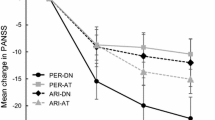Abstract
Quetiapine (Seroquel, ICI 204,636) is an atypical antipsychotic that is effective in the treatment of both positive and negative symptoms of schizophrenia, and has a low propensity to cause extrapyramidal symptoms. The compound has a relatively short plasma elimination half-life (approximately 7 h). However, since dopamine D2 receptor occupancies correlate poorly with plasma concentrations of antipsychotics, plasma elimination half-life may not predict either duration of clinical effect or dosing frequency. Accordingly, the efficacy and tolerability of three dosing regimens (450 mg/day given in two or three divided doses daily, and 50 mg/day given twice daily) were compared in a 6-week, double-blind, randomized, multicentre, parallel-group study. The study recruited hospitalized men and women aged 18–65 years meeting DSM-IIIR criteria for acute exacerbation of chronic or subchronic schizophrenia. Six hundred and eighteen patients were randomly assigned to treatment with quetiapine 150 mg tid (n = 209), 225 mg bd (n = 200), or a comparator dose of 25 mg bd (n = 209). At day 42, the last day of randomized treatment and the primary timepoint for efficacy, quetiapine 450 mg/day was more effective than 50 mg/day: 225 mg bd was consistently superior to 25 mg bd in all measures of efficacy (total BPRS, P = 0.006; CGI severity, CGI improvement and SANS, P < 0.03), and 150 mg tid was statistically significantly superior to 25 mg bd with respect to BPRS total score (P = 0.05). The 225 mg bd and 150 mg tid groups were not significantly different from each other with respect to any efficacy measure. Quetiapine was generally well tolerated. Extrapyramidal symptom (EPS) adverse events were generally rare, and occurred with similar frequencies in the two 450 mg/day groups. Quetiapine was not associated with sustained increases in plasma prolactin at any dose. These data support the atypical profile developed from preclinical studies and show that quetiapine is an effective, well tolerated antipsychotic that can be given twice daily.
Similar content being viewed by others
Author information
Authors and Affiliations
Additional information
Received: 16 May 1997/Final version: 13 October 1997
Rights and permissions
About this article
Cite this article
King, D., Link, C. & Kowalcyk, B. A comparison of bd and tid dose regimens of quetiapine (Seroquel) in the treatment of schizophrenia. Psychopharmacology 137, 139–146 (1998). https://doi.org/10.1007/s002130050603
Issue Date:
DOI: https://doi.org/10.1007/s002130050603




